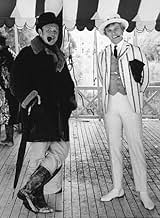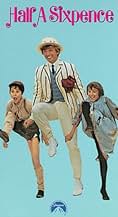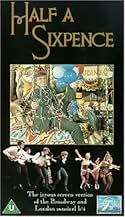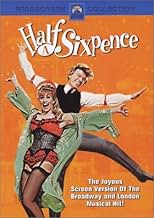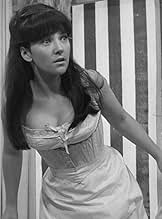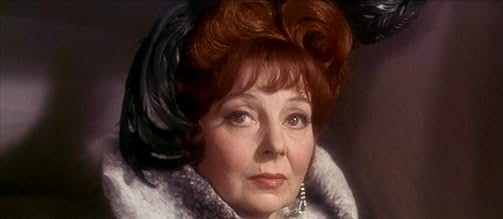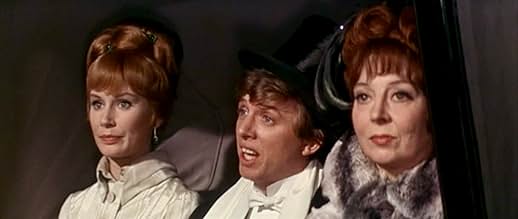VALUTAZIONE IMDb
6,4/10
942
LA TUA VALUTAZIONE
Aggiungi una trama nella tua linguaArthur Kipps, an orphan apprenticed to a tyrannical owner of a mercantile, has a sudden abrupt change of life when his wealthy grandfather dies and leaves him a pile of money.Arthur Kipps, an orphan apprenticed to a tyrannical owner of a mercantile, has a sudden abrupt change of life when his wealthy grandfather dies and leaves him a pile of money.Arthur Kipps, an orphan apprenticed to a tyrannical owner of a mercantile, has a sudden abrupt change of life when his wealthy grandfather dies and leaves him a pile of money.
- Regia
- Sceneggiatura
- Star
- Nominato ai 1 BAFTA Award
- 2 candidature totali
Recensioni in evidenza
Master showmen were at work in the production of this perhaps over long but nevertheless delightful picture. It would be impossible to visualise the film without the warm performance of Tommy Steele, and it was an inspired move to bring in George Sidney, one of Hollywood's finest directors of musicals, to give the picture a very special flare. The budget was obviously huge and it all shows on the screen in the very lively production numbers, especially those shot on location. A super piece of screen entertainment which stands up well to occasional re-watching.
This is a very well acted and energetic musical. Tommy Steel and Julie Foster in the lead parts were brilliantly cast.
The banjo scene in this was well choreographed, put together and acted out. To top the whole scene the banjo playing was superb.
A brilliant family musical it gets a 10/10 from us. But then we are Tommy Steele fans.
The banjo scene in this was well choreographed, put together and acted out. To top the whole scene the banjo playing was superb.
A brilliant family musical it gets a 10/10 from us. But then we are Tommy Steele fans.
I "accidentally" discovered HALF A SIXPENCE during 1979 on the late movie on NYC's Channel 5. I turned it on just before the "Half a Sixpence" number between Tommy Steele and Julia Foster. I didn't get to see it all, but years later it was shown on the Disney Channel. What a great movie! Great choreography (Gillian Lynne of CATS fame), charming actors playing the leads, and all that beautiful on-location photography in England! Tommy Steele sets the screen on fire when he lets loose in a dance number, and his star turn in the role of a simple lad who gets too rich too quickly and ends up miserable is believable and touching. Julia Foster is by turns sweet, vulnerable, AND feisty as his love interest, Ann.
The film (based on the London/Bdwy stage show and directed by movie-musical veteran George Sidney) has the look and feel of an old-fashioned MGM musical, which is probably why I loved it so. It seems to be more widely known in the UK - I believe it was more popular there than in the States at the time of its release, and perhaps it gets more TV airings in the UK? It's just too bad that it's not seen more often and appreciated as it deserves.
The film (based on the London/Bdwy stage show and directed by movie-musical veteran George Sidney) has the look and feel of an old-fashioned MGM musical, which is probably why I loved it so. It seems to be more widely known in the UK - I believe it was more popular there than in the States at the time of its release, and perhaps it gets more TV airings in the UK? It's just too bad that it's not seen more often and appreciated as it deserves.
"Half a Sixpence" was a product of the age of big budget musicals that began with the success of "The Sound of Music" and died when such clunkers as "Mame" and "Man of La Mancha" appeared. As such, the film both benefited and suffered. The benefits were a generous budget that is apparent on screen in the period costumes and sets, the lush photography of the English countryside, and the large cast. Just renting all the antique cars as background for one short scene must have cost a fortune. However, the film also suffered as it was lost in the glut of these big budget musicals, which were often mediocre, and its star, Tommy Steele, did not have the name or the charisma to carry it alone as the cast is largely unknown. The film also suffered from the obligatory over-length and intermission, which were required at the time in order to justify reserved seat engagements for these "event" films. The movie has been seldom seen, at least in the U.S., which is unfortunate because "Half a Sixpence" is a lively family film with a tuneful score, energetic choreography, and an engaging cast. Also, director George Sidney is a veteran of MGM musicals, and he knows how to stage a number. True, the story of how boorish, snotty, and unhappy the rich are, while the poor are fun loving, generous, and content with their lot, has been done to death (see "Titanic"). However, the film's assets lie where a musical's assets should be: in the songs, the dancing, and the performers. On those counts, the film is a winner.
Half A Sixpence is a musical adapted from the H.G. Wells story Kipps which Michael Redgrave played the title role back in a 1941 film version. I'm sure his interpretation of the role differed quite a bit from the boisterous styling of Tommy Steele in this film. They're so different in personality types.
It wasn't Wells the interpreter of the scientific future who wrote Kipps, but rather the Wells who was the Fabian Socialist. In a way this should be seen back to back with Pygmalion or My Fair Lady if you will. Some of the same themes were also done American style in The Unsinkable Molly Brown.
George Bernard Shaw when he wrote Pygmalion did the exact reverse of what Wells did in Kipps. That other noted Fabian Socialist took the flower girl Eliza and had her schooled in manners by the overbearing Henry Higgins to improve her station. Her economic status doesn't improve any, unless you figure she might marry well like the Freddy Eynsford-Hill character. She speaks well enough to fit in with his crowd.
But the exact opposite happens to Arthur Kipps. He's of illegitimate birth, apprenticed as a draper's assistant and living in the basement of his employer's store with other apprentices. But one fine day, Arthur's ship comes in, a grandfather leaves him an inheritance and a guaranteed annual income.
But unlike Audrey Hepburn, Tommy Steele is still at heart from the lower classes. So the story of Half A Sixpence is his personal struggle to find his place. That could be with a girl of his own class, Julia Foster or the previous unattainable Penelope Horner. Give you one guess where Steele winds up.
Half A Sixpence ran on Broadway for 511 performances in the 1965-66 season with Tommy Steele in the title role there. Steele's infectious style of performing is awfully hard to resist. Though he started out as a rock and roll singer, a British answer to Elvis Presley, Steele is really from the great tradition of Music Hall performers in the United Kingdom.
The socialist polemics are kept to a minimum here, I can't speak for how Wells originally wrote Kipps or how Michael Redgrave played it back in the day. But his points do come across and come across most entertainingly.
It wasn't Wells the interpreter of the scientific future who wrote Kipps, but rather the Wells who was the Fabian Socialist. In a way this should be seen back to back with Pygmalion or My Fair Lady if you will. Some of the same themes were also done American style in The Unsinkable Molly Brown.
George Bernard Shaw when he wrote Pygmalion did the exact reverse of what Wells did in Kipps. That other noted Fabian Socialist took the flower girl Eliza and had her schooled in manners by the overbearing Henry Higgins to improve her station. Her economic status doesn't improve any, unless you figure she might marry well like the Freddy Eynsford-Hill character. She speaks well enough to fit in with his crowd.
But the exact opposite happens to Arthur Kipps. He's of illegitimate birth, apprenticed as a draper's assistant and living in the basement of his employer's store with other apprentices. But one fine day, Arthur's ship comes in, a grandfather leaves him an inheritance and a guaranteed annual income.
But unlike Audrey Hepburn, Tommy Steele is still at heart from the lower classes. So the story of Half A Sixpence is his personal struggle to find his place. That could be with a girl of his own class, Julia Foster or the previous unattainable Penelope Horner. Give you one guess where Steele winds up.
Half A Sixpence ran on Broadway for 511 performances in the 1965-66 season with Tommy Steele in the title role there. Steele's infectious style of performing is awfully hard to resist. Though he started out as a rock and roll singer, a British answer to Elvis Presley, Steele is really from the great tradition of Music Hall performers in the United Kingdom.
The socialist polemics are kept to a minimum here, I can't speak for how Wells originally wrote Kipps or how Michael Redgrave played it back in the day. But his points do come across and come across most entertainingly.
Lo sapevi?
- QuizAfter the critical and commercial failure of the film, director George Sidney retired from directing at the age of only 51.
- BlooperIn the song, "Money to Burn", where Kipps (Tommy Steele) is playing the banjo, it's obvious that he's simply playing along to an audio track. But the sound begins several times before he does the strumming to make it happen. This should have been watched/caught in the editing process.
- Citazioni
Harry Chitterlow: Don't forget old Harry. For £100, I'll let you have a quarter share of my new play.
Arthur Kipps: A quarter share? I'll take half!
Harry Chitterlow: Spoken like a gent!
- ConnessioniFeatured in The 100 Greatest Musicals (2003)
I più visti
Accedi per valutare e creare un elenco di titoli salvati per ottenere consigli personalizzati
- How long is Half a Sixpence?Powered by Alexa
Dettagli
- Data di uscita
- Paese di origine
- Lingua
- Celebre anche come
- Half a Sixpence
- Luoghi delle riprese
- Aylesford, Kent, Inghilterra, Regno Unito(village where Kipps grows up)
- Azienda produttrice
- Vedi altri crediti dell’azienda su IMDbPro
- Tempo di esecuzione2 ore 23 minuti
- Proporzioni
- 2.35 : 1
Contribuisci a questa pagina
Suggerisci una modifica o aggiungi i contenuti mancanti

Divario superiore
By what name was Lo squattrinato (1967) officially released in Canada in English?
Rispondi

